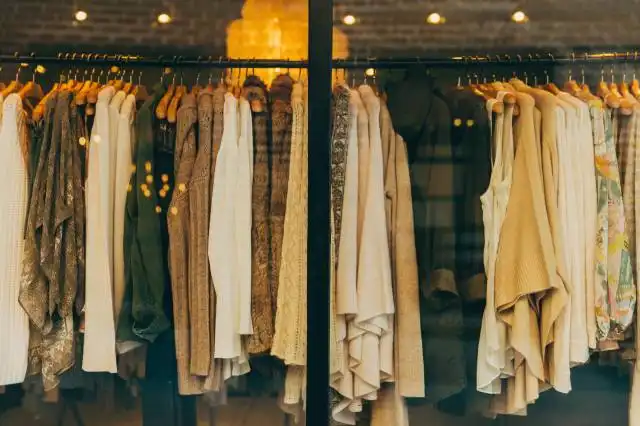Start a Jewelry Store
Diamond Dreams: Embark on a Sparkling Journey in Jewelry Entrepreneurship
| Updated


JEWELRY STORE
Dazzle the world with your taste in sparkle by opening a Jewelry Store. As your own jewelry impresario, your business would involve selling a variety of fine and fashion jewelry, ranging from precious metals, gemstones, to trendy everyday pieces. Here's where emotions translate into purchases, imagine being part of those grand proposals or gifting moments with your beautifully crafted bijouterie! Redefine luxury by making exclusive and unique statements in personal adornment.
Jump to Business Plan
RELATED BUSINESS IDEAS
Browse ALL Retail & Shopping Business Ideas
Discover Your Perfect Domain
Unlock the door to your online success with our hand-picked selection of premium domain names. Whether you're starting a new venture or rebranding an existing one, the right domain can set the tone for your digital presence. Browse through our curated list, each with its unique potential to enhance your brand's visibility and credibility.
JEWELRY STORE MINI BUSINESS PLAN
This a quick reality check to help you identify the strengths and weaknesses of your business concept before you dive in.
Business Idea: Jewelry Store
Expected Percent Margins:
- Gross Margin: 42-50%
- Net Profit Margin: 6-8%
Earnings Expectations:
- Daily Earnings: $100 - $500
- Weekly Earnings: $700 - $3,500
- Monthly Earnings: $3,000 - $15,000
- Annual Earnings: $36,000 - $180,000
Actions to Hit Those Numbers:
Inventory Management:
- Initial Investment: Investment in quality and diverse inventory could vary widely from $10,000 to $50,000.
- Supplier Network: Build a robust relationship with trusted suppliers and wholesalers.
Marketing and Customer Acquisition:
- Digital Marketing: Invest in SEO and PPC campaigns to drive online sales.
- Social Media: Regular posts and campaigns on platforms such as Instagram and Facebook
Sales and Customer Experience:
- Staff Training: Well-trained and knowledgeable staff to help customers and execute effective sales techniques.
- Customer Experience: Enhance and personalize the customer experience through initiatives like after-sales services, personalized suggestions, etc.
Cost Control:
- Rent: Choose a location with rent not exceeding 10% of your expected monthly sales.
- Utilities and Maintenance: Budget around $500-$800 per month.
Business Operations:
- Operating Hours: Open at least 6 days a week, 8 hours a day to maximize sales opportunities.
- Transaction Volume: Aim for an average of 15-20 transactions per day with an average sale price of $50-$200.
These are general estimations and can vary depending on location, economic conditions, and individual business strategies. It's always smart to consult with a financial advisor for personalized advice.
NOT WHAT YOU HAD IN MIND? Here are more ideas



Browse ALL Retail & Shopping Business Ideas
Grab Your Business Website Name
Before you get caught up in the whirlwind of setting up your business, invest in a domain name. It's a small but significant step that lays the foundation for your brand and makes it easier for customers to find and trust you. Just like you wouldn't build a house without securing the land first, don't build a business without securing your domain name.
"Why? Can't that wait?" Here's why it shouldn't
Step 1: Determine if Starting a Jewelry Store is the Right Endeavor
Breakdown of Startup Expenses
Starting a jewelry store requires a significant amount of capital, and it is important to have a clear understanding of the startup costs. These costs can include the cost of the building or store front, any necessary renovations, the cost of inventory, the cost of any necessary equipment, and the cost of any necessary licenses or permits. Additionally, the cost of advertising, marketing, and staffing should be factored in. It is important to have a clear understanding of the total cost of starting a jewelry store, and to make sure that the business has the necessary capital to cover these costs.
Breakdown of Ongoing Expenses
In addition to the startup costs, it is important to understand the ongoing expenses associated with running a jewelry store. These costs can include the cost of rent, utilities, inventory, staffing, and marketing. Additionally, the cost of insurance and any necessary repairs should be factored in. It is important to have a clear understanding of the ongoing expenses associated with running a jewelry store, and to make sure that the business has the necessary capital to cover these costs.
Examples of Ways to Make Money
There are a variety of ways to make money with a jewelry store. These can include selling jewelry, offering jewelry repair services, and offering custom jewelry design services. Additionally, the store can offer other services such as appraisals, engraving, and watch repair. It is important to have a clear understanding of the different ways to make money with a jewelry store, and to make sure that the business is offering services that will be profitable.
Step 2: Name the Business
Naming a business is an important step in the process of starting a jewelry store. It is important to choose a name that is memorable and unique, and that reflects the type of jewelry store you are opening. Consider using a combination of words that evoke the type of jewelry you will be selling, such as “Gemstone Jewels” or “Silver and Gold Boutique.” Additionally, you should make sure the name is not already in use by another business. Research the name you’ve chosen to make sure it is not already trademarked. Additionally, you should also make sure the domain name is available for a website and that the name is available on social media platforms.
You should also consider the legal implications of the name you choose. Depending on the type of business structure you choose, you may need to register the name with your state or local government. Additionally, you may need to register a trademark for the name. This will help protect your business from any potential legal issues in the future.
Finally, you should also consider the marketing implications of the name you choose. Make sure the name is easy to pronounce and spell, so that customers can easily find your business. Additionally, make sure the name is memorable and that it reflects the type of jewelry you will be selling. This will help customers remember your business and be more likely to return.
Step 3: Obtain Licenses and Permits
When starting a jewelry store, it is important to obtain the necessary licenses and permits. Depending on the state, the types of licenses and permits needed may vary. Generally, a business license, a sales tax permit, and a zoning permit are required. Additionally, if the store will be selling jewelry online, a seller’s permit is also necessary. It is important to research the specific requirements for the state in which the business will be located.
Where to Obtain Licenses and Permits
Once the types of licenses and permits needed are determined, the next step is to obtain them. Depending on the state, the licenses and permits can be obtained from the local city hall, the state department of revenue, or the county clerk’s office. Additionally, some states may require the business to register with the Secretary of State. It is important to contact the appropriate government agency to determine the exact process for obtaining the necessary licenses and permits.
Cost of Licenses and Permits
The cost of licenses and permits can vary depending on the state and the type of license or permit. Generally, a business license costs around $50, a sales tax permit costs around $20, and a zoning permit costs around $50. Additionally, a seller’s permit may cost around $25. It is important to research the exact cost of the licenses and permits needed for the state in which the business will be located.
Timeframe for Obtaining Licenses and Permits
The timeframe for obtaining licenses and permits can vary depending on the state. Generally, it takes around two to three weeks to obtain the necessary licenses and permits. It is important to contact the appropriate government agency to determine the exact timeframe for obtaining the necessary licenses and permits.
Step 4: Secure a Location
When deciding on a location for a jewelry store, it is important to consider the area and the potential customer base. It is important to look at the population size, the average income of the area, and the competition. Additionally, the location should be easily accessible and have adequate parking. It is also important to consider the cost of leasing or purchasing the space.
Benefits of an Online Store
In addition to a physical location, many jewelry stores are now opting to open an online store as well. This can be beneficial as it can reach a larger customer base and can be more cost-effective than a physical location. An online store can also be beneficial as it can be open 24/7 and can be managed from anywhere. Additionally, it can be easier to manage inventory and track customer data.
Benefits of a Pop-Up Shop
Pop-up shops can be a great way to test the market and get the word out about the business. Pop-up shops are typically temporary and can be set up in a variety of locations. They can be a great way to get exposure and reach potential customers. Additionally, they can be a great way to test out different products and get feedback from customers.
Step 5: Purchase Supplies and Inventory
When starting a jewelry store, it is important to purchase the necessary supplies and inventory to get the business up and running. There are a few different sources to consider when purchasing supplies and inventory. First, you can purchase supplies and inventory from wholesalers. Wholesalers are companies that specialize in selling bulk quantities of products at discounted prices. This is a great option for those who are looking to purchase large quantities of supplies and inventory at a discounted rate. Additionally, you can purchase supplies and inventory from manufacturers. Manufacturers are companies that specialize in producing products for sale. This is a great option for those who are looking to purchase specific products that may not be available from wholesalers. Finally, you can purchase supplies and inventory from retailers. Retailers are companies that specialize in selling products directly to consumers. This is a great option for those who are looking to purchase smaller quantities of supplies and inventory at a higher price.
Tips for Purchasing Supplies and Inventory
When purchasing supplies and inventory for your jewelry store, there are a few tips to keep in mind. First, it is important to research the different suppliers available to ensure that you are getting the best quality products at the best prices. Additionally, it is important to compare prices between different suppliers to ensure that you are getting the best deal. It is also important to purchase supplies and inventory in bulk, as this will help to reduce costs. Finally, it is important to purchase a variety of supplies and inventory to ensure that you have a wide selection of products to offer your customers.
Step 6: Create a Business Plan
Creating a business plan is an essential step in starting a jewelry store. A business plan is a document that outlines the goals of the business, the strategies to achieve those goals, and the resources needed to execute the strategies. A business plan should include the following components:
Executive Summary: This section provides an overview of the business, its mission, and its goals. It should also include a brief description of the products and services offered.
Market Analysis: This section should include an analysis of the current jewelry market, including the size of the market, the target market, and any trends in the industry. It should also include a competitive analysis of the current jewelry stores in the area.
Business Structure: This section should include information about the legal structure of the business, such as whether it is a sole proprietorship, partnership, or corporation. It should also include information about the ownership structure and any partners involved.
Financial Plan: This section should include a detailed breakdown of the startup costs, ongoing expenses, and potential sources of revenue. It should also include a financial projection for the first few years of the business.
Management Plan: This section should include information about the management team, such as their experience and qualifications. It should also include a description of the roles and responsibilities of each team member.
Marketing Plan: This section should include a description of the marketing strategies that will be used to promote the business. It should also include information about the target market and how the business will reach them.
Implementation Plan: This section should include a timeline for launching the business and a plan for how the business will be managed. It should also include information about any additional resources that may be needed.
Step 7: Market the Business
When it comes to marketing a jewelry store, there are a few different approaches that can be taken. One of the most effective ways to market a business is through online platforms, such as social media and search engine optimization. Social media is a great way to reach potential customers and build relationships with them. It is also a great way to showcase the products that the store has to offer. Additionally, search engine optimization can help to ensure that customers can easily find the store when they search for jewelry stores in the area. Additionally, traditional marketing methods, such as print ads, radio, and television can also be used to reach potential customers.
Tips for Developing a Marketing Plan
When it comes to developing a marketing plan, it is important to consider the target audience and the goals for the business. It is also important to consider the budget for marketing and the timeline for when the marketing will take place. Additionally, it is important to consider the different methods that will be used to reach potential customers. It is also important to consider the different types of promotions that can be used to attract customers and create brand awareness. Finally, it is important to track the results of the marketing plan to ensure that it is successful.
Step 8: Hire Employees
Hiring employees is an important step in starting a jewelry store. When hiring employees, it is important to look for individuals who have a passion for jewelry and customer service. It is also important to look for individuals who have experience in sales and customer service. Additionally, it is important to look for individuals who have a good understanding of the jewelry industry and the products that are being sold. It is also important to look for individuals who have a good understanding of the local market and the competition. Finally, it is important to look for individuals who have a good understanding of the store's policies and procedures.
Training Employees
Once the employees have been hired, it is important to provide them with the necessary training. This should include training on the products that are being sold, customer service, and store policies and procedures. Additionally, it is important to provide employees with training on the store's marketing and promotional strategies. This will ensure that employees are able to effectively promote the store and its products. Finally, it is important to provide employees with training on the store's inventory management system. This will ensure that employees are able to accurately track the store's inventory and ensure that the store is adequately stocked.
Step 9: Open the Store
Opening a jewelry store can be a daunting task, but with the right preparation, it can be a successful endeavor. To open the store, there are a few tips to consider. First, make sure to have all the necessary permits and licenses from the local government. This will ensure that the store is operating legally and will help to protect the business from any potential legal issues. Second, it is important to have a grand opening event to attract customers and create a buzz. This could include discounts, giveaways, or even a special guest appearance. Third, it is important to have a good marketing plan to promote the store and its products. This could include advertising in local newspapers, radio, or television, or even using social media to reach a larger audience. Finally, it is important to have a good customer service plan in place. This could include having a friendly and knowledgeable staff, offering a warranty on products, and having a return policy. By following these tips, the jewelry store will be ready to open and start making money.
EXPLORE MORE CATEGORIES
Browse ALL Business Idea Categories
TAKE THE NEXT STEPS










